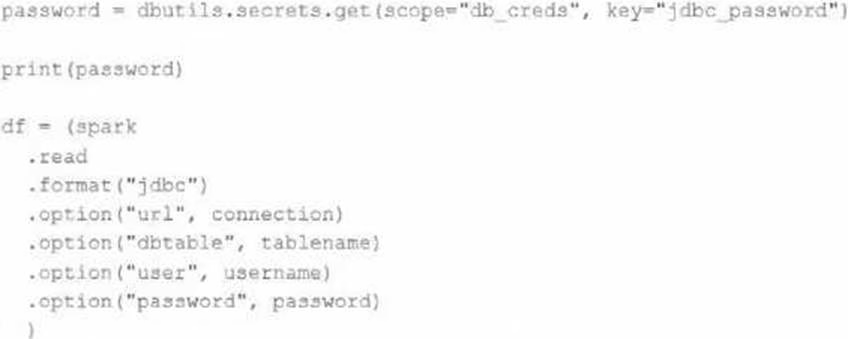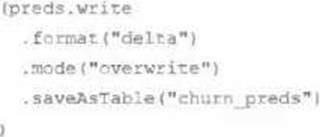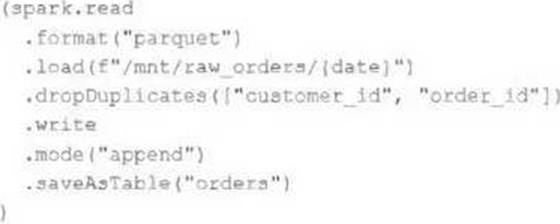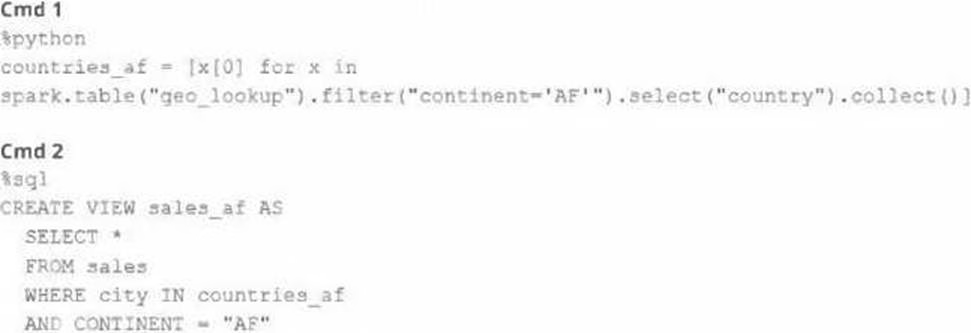Databricks Databricks Certified Professional Data Engineer Databricks Certified Data Engineer Professional Exam Online Training
Databricks Databricks Certified Professional Data Engineer Online Training
The questions for Databricks Certified Professional Data Engineer were last updated at Dec 16,2025.
- Exam Code: Databricks Certified Professional Data Engineer
- Exam Name: Databricks Certified Data Engineer Professional Exam
- Certification Provider: Databricks
- Latest update: Dec 16,2025
An upstream system has been configured to pass the date for a given batch of data to the Databricks Jobs API as a parameter.
The notebook to be scheduled will use this parameter to load data with the following code:
df = spark.read.format("parquet").load(f"/mnt/source/(date)")
Which code block should be used to create the date Python variable used in the above code block?
- A . date = spark.conf.get("date")
- B . input_dict = input()
date= input_dict["date"] - C . import sys
date = sys.argv[1] - D . date = dbutils.notebooks.getParam("date")
- E . dbutils.widgets.text("date", "null")
date = dbutils.widgets.get("date")
The Databricks workspace administrator has configured interactive clusters for each of the data engineering groups. To control costs, clusters are set to terminate after 30 minutes of inactivity. Each user should be able to execute workloads against their assigned clusters at any time of the day.
Assuming users have been added to a workspace but not granted any permissions, which of the following describes the minimal permissions a user would need to start and attach to an already configured cluster.
- A . "Can Manage" privileges on the required cluster
- B . Workspace Admin privileges, cluster creation allowed. "Can Attach To" privileges on the required cluster
- C . Cluster creation allowed. "Can Attach To" privileges on the required cluster
- D . "Can Restart" privileges on the required cluster
- E . Cluster creation allowed. "Can Restart" privileges on the required cluster
When scheduling Structured Streaming jobs for production, which configuration automatically recovers from query failures and keeps costs low?
- A . Cluster: New Job Cluster;
Retries: Unlimited;
Maximum Concurrent Runs: Unlimited - B . Cluster: New Job Cluster;
Retries: None;
Maximum Concurrent Runs: 1 - C . Cluster: Existing All-Purpose Cluster; Retries: Unlimited;
Maximum Concurrent Runs: 1 - D . Cluster: Existing All-Purpose Cluster; Retries: Unlimited;
Maximum Concurrent Runs: 1 - E . Cluster: Existing All-Purpose Cluster; Retries: None;
Maximum Concurrent Runs: 1
The data engineering team has configured a Databricks SQL query and alert to monitor the values in
a Delta Lake table. The recent_sensor_recordings table contains an identifying sensor_id alongside the timestamp and temperature for the most recent 5 minutes of recordings.
The below query is used to create the alert:

The query is set to refresh each minute and always completes in less than 10 seconds. The alert is set to trigger when mean (temperature) > 120. Notifications are triggered to be sent at most every 1 minute.
If this alert raises notifications for 3 consecutive minutes and then stops, which statement must be true?
- A . The total average temperature across all sensors exceeded 120 on three consecutive executions of the query
- B . The recent_sensor_recordingstable was unresponsive for three consecutive runs of the query
- C . The source query failed to update properly for three consecutive minutes and then restarted
- D . The maximum temperature recording for at least one sensor exceeded 120 on three consecutive executions of the query
- E . The average temperature recordings for at least one sensor exceeded 120 on three consecutive executions of the query
A junior developer complains that the code in their notebook isn’t producing the correct results in the development environment. A shared screenshot reveals that while they’re using a notebook versioned with Databricks Repos, they’re using a personal branch that contains old logic. The desired branch named dev-2.3.9 is not available from the branch selection dropdown.
Which approach will allow this developer to review the current logic for this notebook?
- A . Use Repos to make a pull request use the Databricks REST API to update the current branch to dev-2.3.9
- B . Use Repos to pull changes from the remote Git repository and select the dev-2.3.9 branch.
- C . Use Repos to checkout the dev-2.3.9 branch and auto-resolve conflicts with the current branch
- D . Merge all changes back to the main branch in the remote Git repository and clone the repo again
- E . Use Repos to merge the current branch and the dev-2.3.9 branch, then make a pull request to sync with the remote repository
The security team is exploring whether or not the Databricks secrets module can be leveraged for connecting to an external database.
After testing the code with all Python variables being defined with strings, they upload the password to the secrets module and configure the correct permissions for the currently active user. They then modify their code to the following (leaving all other variables unchanged).

Which statement describes what will happen when the above code is executed?
- A . The connection to the external table will fail; the string "redacted" will be printed.
- B . An interactive input box will appear in the notebook; if the right password is provided, the connection will succeed and the encoded password will be saved to DBFS.
- C . An interactive input box will appear in the notebook; if the right password is provided, the connection will succeed and the password will be printed in plain text.
- D . The connection to the external table will succeed; the string value of password will be printed in plain text.
- E . The connection to the external table will succeed; the string "redacted" will be printed.
The data science team has created and logged a production model using MLflow. The following code correctly imports and applies the production model to output the predictions as a new DataFrame named preds with the schema "customer_id LONG, predictions DOUBLE, date DATE".

The data science team would like predictions saved to a Delta Lake table with the ability to compare all predictions across time. Churn predictions will be made at most once per day.
Which code block accomplishes this task while minimizing potential compute costs?
A) preds.write.mode("append").saveAsTable("churn_preds")
B) preds.write.format("delta").save("/preds/churn_preds")
C)

D)

E)

- A . Option A
- B . Option B
- C . Option C
- D . Option D
- E . Option E
An upstream source writes Parquet data as hourly batches to directories named with the current date.
A nightly batch job runs the following code to ingest all data from the previous day as indicated by the date variable:

Assume that the fields customer_id and order_id serve as a composite key to uniquely identify each order.
If the upstream system is known to occasionally produce duplicate entries for a single order hours apart, which statement is correct?
- A . Each write to the orders table will only contain unique records, and only those records without duplicates in the target table will be written.
- B . Each write to the orders table will only contain unique records, but newly written records may have duplicates already present in the target table.
- C . Each write to the orders table will only contain unique records; if existing records with the same key are present in the target table, these records will be overwritten.
- D . Each write to the orders table will only contain unique records; if existing records with the same key are present in the target table, the operation will tail.
- E . Each write to the orders table will run deduplication over the union of new and existing records,
ensuring no duplicate records are present.
A junior member of the data engineering team is exploring the language interoperability of Databricks notebooks. The intended outcome of the below code is to register a view of all sales that occurred in countries on the continent of Africa that appear in the geo_lookup table.
Before executing the code, running SHOW TABLES on the current database indicates the database contains only two tables: geo_lookup and sales.

Which statement correctly describes the outcome of executing these command cells in order in an interactive notebook?
- A . Both commands will succeed. Executing show tables will show that countries at and sales at have been registered as views.
- B . Cmd 1 will succeed. Cmd 2 will search all accessible databases for a table or view named countries af: if this entity exists, Cmd 2 will succeed.
- C . Cmd 1 will succeed and Cmd 2 will fail, countries at will be a Python variable representing a PySpark DataFrame.
- D . Both commands will fail. No new variables, tables, or views will be created.
- E . Cmd 1 will succeed and Cmd 2 will fail, countries at will be a Python variable containing a list of strings.
A Delta table of weather records is partitioned by date and has the below schema:
date DATE, device_id INT, temp FLOAT, latitude FLOAT, longitude FLOAT
To find all the records from within the Arctic Circle, you execute a query with the below filter:
latitude > 66.3
Which statement describes how the Delta engine identifies which files to load?
- A . All records are cached to an operational database and then the filter is applied
- B . The Parquet file footers are scanned for min and max statistics for the latitude column
- C . All records are cached to attached storage and then the filter is applied
- D . The Delta log is scanned for min and max statistics for the latitude column
- E . The Hive metastore is scanned for min and max statistics for the latitude column
Latest Databricks Certified Professional Data Engineer Dumps Valid Version with 222 Q&As
Latest And Valid Q&A | Instant Download | Once Fail, Full Refund

